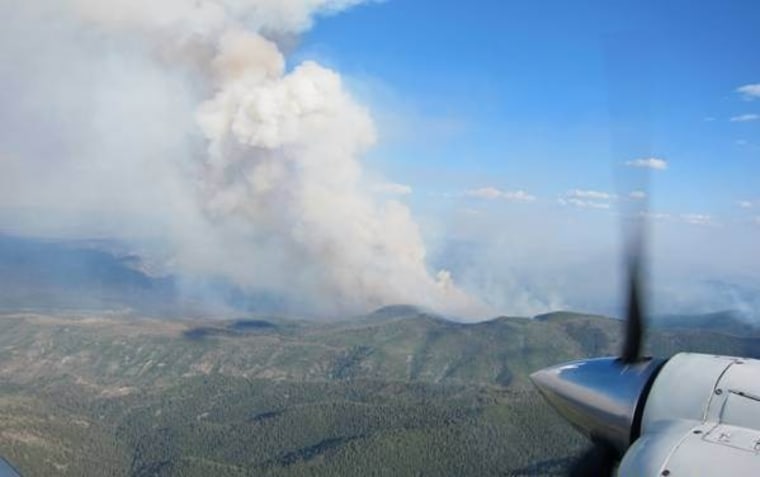Critical fire conditions continued Friday across the dry and windy Southwest -- including New Mexico where a massive wildfire destroyed a dozen homes and left a smoky haze over Albuquerque that one weatherman described as "stinky."
Haze from the fire covered much of the state and the smell moved overnight into Albuquerque, which is 170 miles from the fire, NBC affiliate KOB-TV reported.
"It's a little bit stinky," KOB weatherman Steve Stucker said on Friday morning's news show.
"A lot of wind," including 60 mph gusts, is expected through the Sunday making for rough fire conditions, he added.
Crews have not been able to cut a containment line ahead of the fire, which threatens more homes after destroying 12 in the Willow Creek community.
The wildfire, which has burned 130 square miles, is the biggest of a dozen burning in parts of five Southwestern states.
Blazes in rugged, mountainous areas of Arizona, Colorado, Nevada, New Mexico and Utah have forced the evacuation of a few small towns and torched at least 200 square miles of forest, brush and grass since mid-month.
In San Diego County, Calif., the Banner Fire scorched 3100 acres east of Julian as of 6 p.m. PT Friday, NBCSanDiego.com reported. Containment reached 20 percent thanks in part to damp conditions overnight, firefighters said.
After an initial threat to the community of Shelter Valley, the brush fire is no longer threatening structures or homes. Instead, it's burning toward open land to the east.
The flames started around 2:15 p.m. off Banner Grade in Cigarette Hill spread rapidly toward Granite Peak.
Evacuations were ordered for 100 homes. Approximately 300 people were told to gather what they could and evacuate. Thursday night Cal FIRE reported residents could return to their homes.
Friday afternoon, residents in the Stagecoach Trails RV Park between Monument Rd. and SR-78 were given a mandatory evacuation order.
The Arizona fires were the first major blazes in the Grand Canyon state this year after a record 2011 fire season in which nearly 2,000 fires charred more than 1,500 square miles, according to the National Interagency Fire Center.
Some 1,100 firefighters using aircraft and hand tools made progress toward containing the so-called Gladiator Fire.
That fire, which has torched more than 25 square miles of ponderosa pine and brush about 40 miles north of Phoenix, was 35 percent contained on Friday.
"The winds we've gotten here in the last 24 hours have brought in some moisture from Baja (California)," Dave Killebrew, a spokesman for the local fire incident team, said Thursday.
"Humidity reached up to as high as 50 percent in some areas of the fire, which is excellent ... That means that the fuels won't be nearly as volatile as they have been for the last few days when we've had relative humidity down as low as 3-5 percent," he added.
Killebrew said good progress was being made securing containment lines around the blaze, which forced the evacuation of the town of Crown King and three other tiny communities nearby.
In northern Nevada, lighter winds and higher humidity helped crews' efforts to curb the Topaz Ranch Estates wildfire that has razed more than 11 square miles of brush south of Carson City, charring two homes and 17 outbuildings.
No homes were immediately threatened and an evacuation order was lifted on Wednesday. While gusting winds challenged firefighters, rains and cooler temperatures were expected to help crews bring the flames under control by Saturday.
Crews battling the 25-square-mile Sunflower Fire, in Arizona, had succeeded in reinforcing control lines and it was more than 40 percent under control.
Across the country in Michigan, two wildfires sparked by lightning strikes burned in forests and marshes of the sparsely populated Northern Peninsula, which is stuck in an extended dry spell, authorities said.
The larger of the two, the Duck Lake Fire has burned about 17,000 acres to the Lake Superior coastline. The blaze has consumed dozens of structures, including vacation homes, and forced some evacuations of campers, but caused no injuries.
There was no containment, as gusty winds had shifted to westerly breezes, threatening the Pike Lake area where there is a resort.
Another fire has blackened 3,000 acres of the Seney National Wildlife Refuge, but has threatened no structures and is 65 percent contained. Planes and helicopters were dumping water on the fire, and ground crews had dug a fire line.
The Seney reserve covers nearly 100,000 acres, and the fire has burned forest and wetlands. Authorities have asked that people avoid any open fires, because conditions are very dry in the peninsula.
